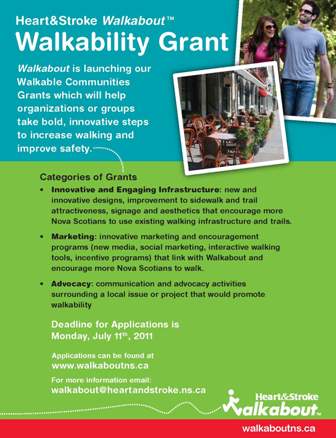Creating Walkable CommunitiesCreating walkable communities is essential to ensure we are creating healthy, safe and accessible neighbourhoods for all. In 2005, Canadians' most popular leisure-time physical activity was walking. A majority of men and women (64% and 76%, respectively) reported walking in their leisure time (Gilmour H. Health Reports (Statistics Canada, catalogue 82-003) 2007; 18 (3): 45-65). Walking is a critical component of our urban transportation system and a practical transportation choice with powerful benefits for both individuals and their communities. How can I make an impact?By taking action in your municipality, town, community or neighbourhood, policies can be influenced to make certain that where you live, work, learn and play will be designed for walking and to support residents to be active. Please see our Shaping Healthy, Active Communities Toolkit, workshops and presentations for more information. Walkability GrantApplications are no longer being accepted for the Walkability Grant, winners will be announced here soon. 
What are walkable communities? Walkable communities are an important aspect of a healthy and vibrant community. Well-designed, compact communities where people can walk to school and work, stores, parks and restaurants significantly reduce the need to drive. 
Why are walkable communities important?- Health: Reducing the health risks such as obesity, diabetes and heart disease currently faced in our communities
- Environment: Replacing short distance auto trips that damage the environment by impacting air and water quality
- Road Traffic and Congestion: Reducing road congestion and improving safety by calming auto traffic and reducing maintenance costs
- Society: Promoting community cohesion and a heightened sense of place. Discouraging street crime by increasing pedestrian and cycling traffic. Reintroducing residents to the street to enhance their awareness of the environment
- Economy: Reducing health care costs by increasing the health of residents. Improving access to employment, education and social services. Reducing servicing costs related to sprawl
Source: www.walkon.ca |